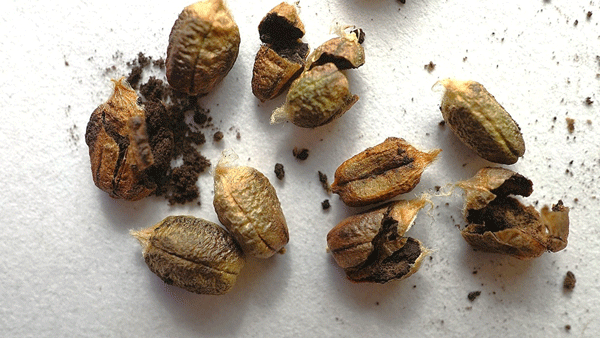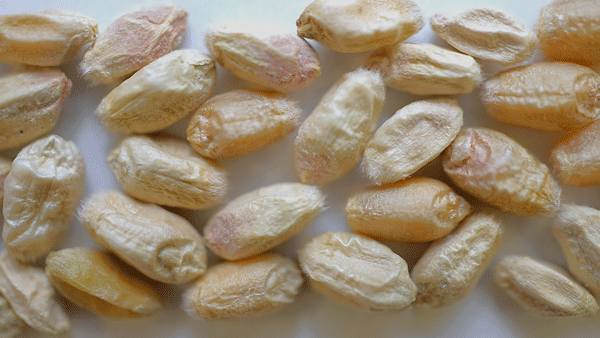Seed treatments are an important part of wheat production in Kansas. The updated K-State publication MF2955, Fungicide Seed Treatments for Wheat Disease Management, is available at http://www.ksre.ksu.edu/bookstore/pubs/MF2955.pdf
This publication provides information about setting seed treatment priorities, considerations for seed treatment success, a key to common seed treatment active ingredients, and a list of some of the more common seed treatments labeled for use in Kansas.
Most fungicide seed treatments provide protection against several seed-borne diseases (common bunt, loose smut, flag smut) and seedling diseases that may result in poor emergence or damping off. Additionally, fungicide seed treatments should be a priority if seed is saved from fields with Fusarium head blight.
Additional benefits of seed treatments:
Fungicide seed treatments help keep seed-borne diseases such as smuts and bunts in check. Loose smut (Figure 1) and common bunt, sometimes called “stinking smut” (Figure 2), can be controlled very effectively with most commercial treatments that contain fungicides. Some regions of the state have struggled with these diseases in recent years. In 2025, loose smut was particularly prevalent. If you are planning to keep any seed with known exposure to common bunt or loose smut, it is critical to use a fungicide seed treatment to avoid problems in the future.

Figure 1. At heading, heads infected with loose smut will emerge as a black mass of spores and will not produce grain. Spore will infect neighboring plants at flowering, which can lead to a higher incidence in subsequent seasons if seed is saved from infected fields. Fungicide seed treatments should provide complete control of this disease. Photo by Kelsey Andersen Onofre, K-State Research and Extension.

Figure 2. Seed with common bunt (aka stinking smut). Kernels are dark and typically smaller than healthy kernels and can be easily broken open to reveal black spores. These black spores contaminate healthy seed during harvest and can cause increased common bunt in the following season. Fungicide seed treatments should provide complete control of this disease. Photo by Kelsey Andersen Onofre, K-State Research and Extension.
Fusarium head blight (scab) not only causes discoloration of heads, but it can also cause grain to have a lightweight, chalky (sometimes pink) appearance (Figure 3). Seed lots that come from fields that had Fusarium head blight in 2025 may have reduced stand and germination because the fungus that causes this disease can survive in seed and infect seedlings as they emerge. Seed cleaning to remove lightweight kernels and seed treatments with a fungicide can eliminate this issue.

Figure 3. Seed from a field with Fusarium head blight (head scab). Kernels often appear white and occasionally with pink discoloration. Fungicide seed treatments reduced the risk of seedling diseases due to Fusarium. Photo by Kelsey Andersen Onofre, K-State Research and Extension.
Seed production fields are a top priority for fungicide seed treatments. These fields have a high value, and investments in seed treatments here help prevent the introduction and development of seed-borne diseases on your farm. Due to the high value of the seed produced, even small yield increases can justify the use of seed treatments.
Seed treatments can aid stand establishment when planting wheat after soybean harvest, even on seed that has high test weight and good germination. Planting wheat late into cool, wet soils often delays emergence and reduces the tillering capacity of wheat seedlings. This reduced tillering capacity diminishes the plant's ability to compensate for stand loss and maintain yield potential.
Some fungicide seed treatments also suppress the fall development of foliar diseases. For example, treatments containing tebuconazole and difenoconazole provide some protection against fall infections of powdery mildew, leaf rust, and Stagonospora nodorum leaf blotch. It is important to note that most seed treatment fungicides will provide a maximum of 30 days of control. A seed treatment will not prevent the disease from becoming reestablished in the spring, and foliar fungicide applications may still be required to protect the yield potential of the crop.
Things to remember
As with most things in agriculture, producers must balance the possible benefits against the cost. Some growers also prefer not to risk having leftover treated seed to deal with at the end of planting. If the seed is treated on-farm, pay close attention to ensure thorough coverage of the seed. Incomplete coverage can reduce the efficacy of the seed treatment.
There are many different seed treatments available for wheat. Although most seed treatment ingredients are fungicides, some will also contain insecticides. Each ingredient targets a slightly different spectrum of disease-causing fungi or insect pests. Therefore, many commercial formulations include combinations of ingredients that provide a broader spectrum of protection.
Kelsey Andersen Onofre, Extension Plant Pathologist
andersenk@ksu.edu
Romulo Lollato, Extension Wheat Specialist
lollato@ksu.edu